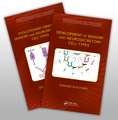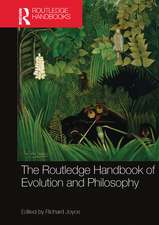Cellular Processes in Segmentation: Evolutionary Cell Biology
Editat de Ariel Chipmanen Limba Engleză Hardback – 20 apr 2020
Key Features
- Explores the role that segmentation has played in the diversity of animals
- Documents the diverse cellular mechanisms by which segmentation develops
- Reviews the independent evolutionary origins of segmentation
- Provides insight into the general patterns of serial homology at the cellular level
Lynne Bianchi. Developmental Neurobiology (ISBN 978-0-8153-4482-7).
Jonathan Bard. Principles of Evolution: Systems, Species, and the History of Life (ISBN 978-0-8153-4539-8).
Gerhard Scholtz. Evolutionary Developmental Biology of Crustacea (ISBN 978-9-0580-9637-1).
Dr. Ariel D. Chipman is Associate Professor in the Department of Ecology, Evolution & Behavior of the Silberman Institute of Life Sciences at The Hebrew University of Jerusalem. He is the author or co-author of dozens of peer reviewed scientific journal articles. His research focuses upon the evolution of animal body plans with a focus on arthropod segmentation, integrating comparative embryology, the fossil record and genome evolution.
Preț: 793.01 lei
Preț vechi: 967.09 lei
-18% Nou
Puncte Express: 1190
Preț estimativ în valută:
151.74€ • 158.43$ • 125.59£
151.74€ • 158.43$ • 125.59£
Carte tipărită la comandă
Livrare economică 05-19 aprilie
Preluare comenzi: 021 569.72.76
Specificații
ISBN-13: 9781138389915
ISBN-10: 1138389919
Pagini: 313
Ilustrații: 60
Dimensiuni: 156 x 234 x 20 mm
Greutate: 0.76 kg
Ediția:1
Editura: CRC Press
Colecția CRC Press
Seria Evolutionary Cell Biology
ISBN-10: 1138389919
Pagini: 313
Ilustrații: 60
Dimensiuni: 156 x 234 x 20 mm
Greutate: 0.76 kg
Ediția:1
Editura: CRC Press
Colecția CRC Press
Seria Evolutionary Cell Biology
Cuprins
Section I: The Diversity of Segmentation. 1: Concepts of Seriality. 2: Diversity in Segmentation Mechanisms. Section II: Cellular Mechanisms of Segmentation. 3: Cellular Oscillators in Vertebrate Segmentation. 4: Cell Movement and Synchronization in Arthropod Segmentation. 5: Cellular Processes in Annelid Segmentation. 6: Scaling in Vertebrate Segmentation. 7: Stem Cells in Crustaceans. 8: Stem Cells in Leeches. Section III: Experimental approaches to segmentation. 9: Segmentation in Non-Segmented Phyla. 10: Live Imaging at the Cellular Level. 11: Regeneration as a Repeat of the Segmentation Process.
Descriere
The evolution of segmentation is a central question in evolutionary developmental biology. Segmented body plans evolved several times in the history of life and contributed to the evolutionary success of these taxa. The book will prove an invaluable reference for students of evolutionary developmental biology at all levels.



































